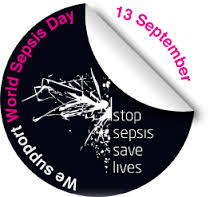I blogged about it at the time here in a post entitled “Sepsis, Scepticemia and Blood Poisoning. Find out about the signs and symptoms of blood poisoning.”
So you can imagine I’m very keen to show my support for Saturday’s World Sepsis Day.
There are loads of different ways the day is being marked by I rather like it that A sepsis survivor, Ian Hillier, 42, from Syston, is helping Leicester’s Hospitals mark World Sepsis Day by releasing 200 balloons at 12pm on Friday September 12 at Leicester Royal Infirmary. Which is in fact the day before!
The 200 balloons represent the number of lives in Leicester that could be saved if sepsis is detected early and properly managed. Which show the extent of the issue in the UK.
The condition, which kills more people than breast cancer in the UK, occurs when an infection starts to overwhelm the body, leading to impaired function of key body organs such as the kidneys, lungs and heart. Early symptoms of sepsis can appear benign, such as flu like illness or a pulled muscle.
Ian, who will be joined by his wife and daughter, said: “I was diagnosed with sepsis in June which had started with what I thought was a pulled muscle in my arm.
“Thanks to the early intervention of my GP and staff at the Royal, it was quickly diagnosed – before it was too late – and the treatment I received during my stay at the Royal saved my life.”
He added: “I’m delighted to have been asked to release these balloons – it’s important we continue to fight this disease which can affect any of us at any time.”
John Ashworth MP, Leicester South, is backing the balloon launch. He said: “As sepsis is estimated to cause 37,000 deaths a year, the work of Leicester’s Hospitals in increasing the recognition and treatment of patients with sepsis is vital.”
Leicester’s Hospitals has introduced a number of initiatives to improve the treatment of patients with sepsis, including training nearly one hundred members of staff to be ‘sepsis champions’.
John Parker, consultant anaesthetist at Leicester’s Hospitals, said: “Our champions will actively promote prompt recognition and treatment of sepsis and ensure it is regarded by all as a medical emergency.
“Treatment within one hour of diagnosis is vital, so clinical staff will also have access to special ‘sepsis 6 boxes’, which we have developed. They contain life saving antibiotics, intravenous fluids and blood culture bottles.”
The newly introduced initiatives have already seen significant improvements in sepsis treatment at Leicester’s Hospitals. In 2013, 27% of patients received intravenous antibiotics within one hour of developing severe sepsis. For the year so far, this figure has risen to 50%.
World Sepsis Day takes place on Saturday 13 September 2014. For more information visit: www.sepsistrust.org
Please feel free to share what you are doing to mark World Sepsis Day in the comments section below.

